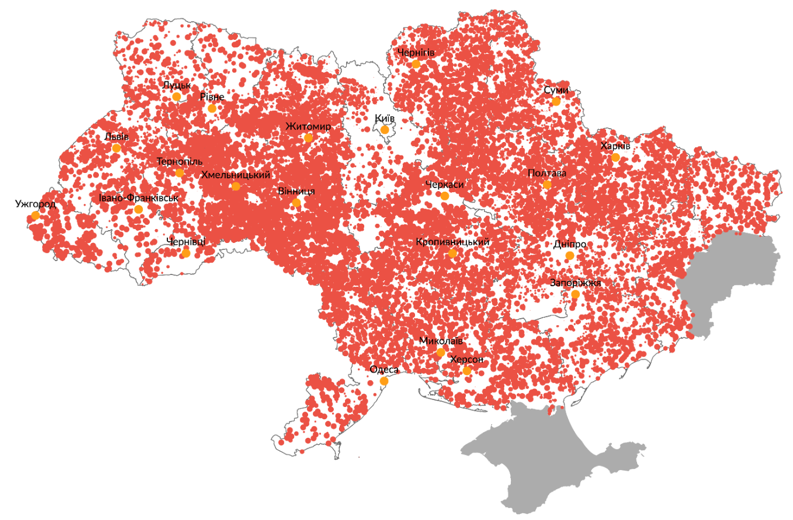Estimating High-speed Broadband Coverage in Ukraine
by Mykhailo Koltsov , Natalija Gelvanovska-GarciaOokla Digital Development
Challenge
Ukraine, Europe’s biggest country, has over 1,192 operators and providers, of which close to three quarters operate under a special preferential tax regime, allowing them not to report their coverage/subscription data to the national telecom regulatory authority. As a result, the current coverage data, especially of fixed broadband, are deemed highly inaccurate. As the government needs to set high-speed broadband coverage goals and estimate financing needs for a public investment program, it is important to validate existing data and evaluate broadband coverage.

Fig. 1: Settlements without fiber optic connectivity, 2020 (Note: Unconnected settlements are marked in Red; the size of the circle for each settlement is proportionate to its population; Source: World Bank based on multiple data sources)
Solution
To estimate the coverage of the high-speed broadband in Ukraine, four different data sources were used to identify and cross-check the status of broadband coverage in Ukraine at the settlement level. The core data on connection speeds are from Ookla. Three additional data sources are used to complement and cross-check these data using official statistics from the Ukrainian government and the Telecommunications regulator (NCCIR): (i) Ministry of Education (MES) data on broadband coverage in schools, (ii) Regulatory data from the NCCIR survey of ISPs as of January 2020, and (iii) Official speed testing data from Broadband.gov.ua.
The settlements without fiber-optic coverage were mapped using a red dot for each settlement with 0 confirmed speed tests at 30 Mbps or above (Fig. 1). A settlement is defined as having no coverage if all four data sources suggest that no user in a given settlement had access to internet connection speeds above 30 Mbps during the period January 1, 2020 - May 30, 2020. As there are 17,988 such settlements (accounting for 12% of the overall population), we make the map more tractable by plotting only settlements with a population of 1,000 or above. In the visualization, the dot size is proportional to the population of the settlement. Temporarily occupied territories and Crimea were excluded from this analysis.

Fig. 2: 4G Mobile broadband coverage, 2019 (Source: Based on analysis by Ookla® of Speedtest Intelligence® data for May 20, 2020. Ookla trademarks used under license and reprinted with permission)
The quality of mobile broadband remains insufficient for communication needs, especially in less populated oblasts and in rural and remote areas. The coverage map of 3G/4G broadband access (Fig. 2) measured by mobile network operators’ (MNOs) speed tests shows that the largest cities have good coverage, whereas the rest of the country is severely underserved.
Impact
Broadband connectivity is a critical foundation for socioeconomic development in today’s global, and increasingly digital, economy. It is a general-purpose technology (GPT) that accelerates the pace of economic growth and reduces income disparities, thus contributing to poverty alleviation. The analyses in this post are excerpted from the World Bank recommendations report on the National Broadband Strategy for the Government of Ukraine. The recommendations seek to achieve the vision of making high-speed broadband available to every citizen, business and private institution in Ukraine by year 2025.